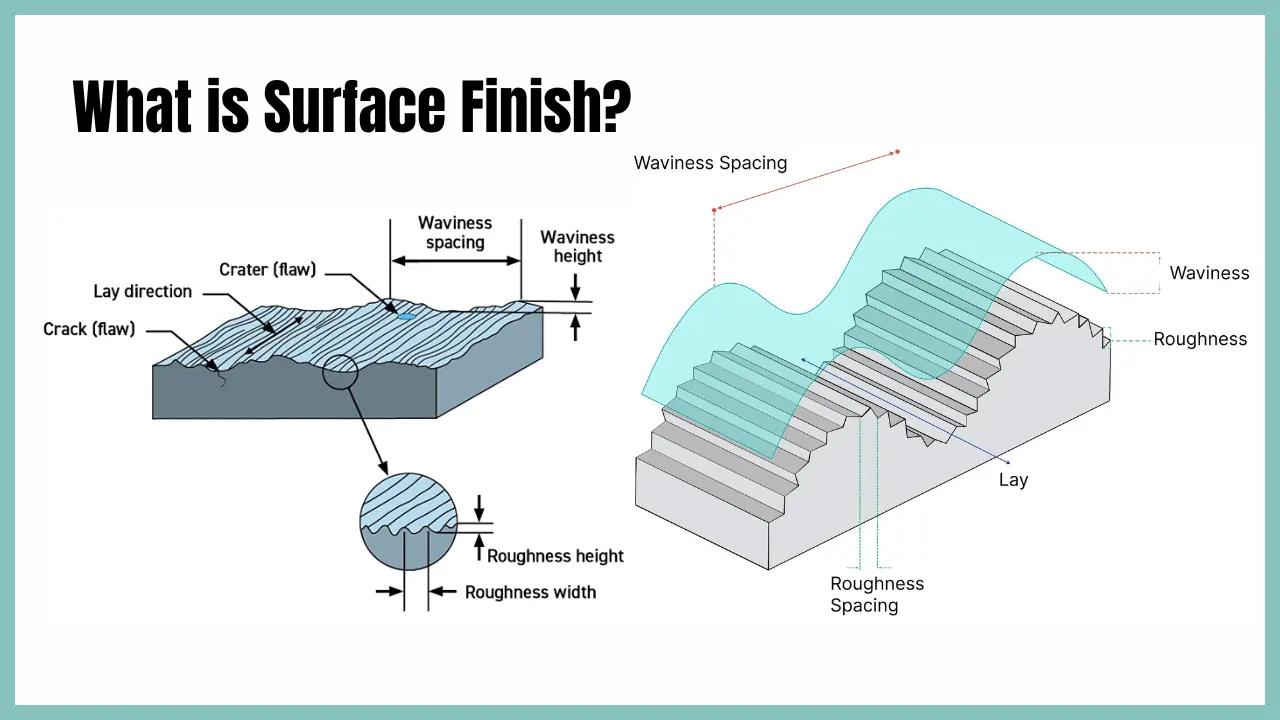Metal products are everywhere around us. Some are shiny and some are matte. Some are metallic and some are colored. The appearance of a metal item depends on just one thing – its surface finish. So,what exactly is surface finishing?Why is it so important? This article will delve into the nature, classification, application and far-reaching impact of this technology on modern society.
What is surface finishing?
Surface finishing is a broad term covering a range of operationsthat remove, add to or reshape metal surfaces through various processes. It is a means of protection that can be chemical, mechanical or electrical and is designed to optimize the appearance, strength and other properties of metal parts.
Metal finishing exhibits unique results, depending on the specific method used. You can flexibly choose one or combinemultiple metal finishingmethods according to your actual needs to ensure that the final product meets the desired quality standards.

What Are the Common Surface Finishing Processes?
Surface finishing processesencompass a variety of techniques designed to optimize the texture, appearance characteristics and overall performance of materials and components. The following are several common surface finishing processes:
| Processes | Description |
| Electrolytic polishing technology | This process can effectively remove impurity ions from the metal surface. It is especially suitable for metals such as stainless steel, aluminum and copper, and can achieve extremely smooth and exquisite surface treatment effects. |
| Spray painting and powder coating | These technologies not only improve the aesthetics of the product but also enhance its corrosion resistance by spraying liquid paint or electrostatic powder, and are widely used in the automotive manufacturing industry. |
| Grinding and sandblasting | As manually operated surface treatment technologies, they remove defects on the surface of materials such as aluminum, carbon steel, and stainless steel through abrasion to achieve a smooth and smooth surface. |
| Electroplating process | Using the action of electric current to deposit metal from the solution to the surface of the substrate, it significantly improves the durability and corrosion resistance of metals such as zinc, copper and gold. |
| Vacuum electroplating technology | It is carried out in a high vacuum environment, including subdivided processes such as sputtering and ion plating, and is especially suitable for the finishing of precision surfaces such as titanium nitride. |
| Chemical finishing technology | The use of chemical reactions to form a thin oxide or sulfide layer on the surface provides an effective means for coloring, anti-corrosion and primer treatment before painting. |
| Powder coating technology | Using electrostatic spraying, the dry powder evenly adheres to the surface and melts and solidifies, providing long-lasting decorative finishes for various items. |
| Thermal spray process | Heats and accelerates materials to mechanically adhere them to surfaces. It is often used for thermal barrier coatings on structural components and other critical applications. |
| Hot dip process | Immersing parts in molten metal solution to form a protective metal coating, which is mainly used to enhance anti-corrosion performance and is commonly used in applications such as guardrails. |
How Does Surface Finishing Improve Metal Products?
Surface finishing plays a vital role in the manufacturingof metal products, significantly improving multiple aspects of metal products through a series of processes. Here are specific wayshow surface finishing can improve metal products:
- Improve corrosion resistance and wear resistance:electroplating, hot plating,anodizing, etc. form a protective film to isolate corrosion; wear-resistant coatings and chemical plating enhance hardness and extend life.
- Enhance aesthetics:change color, gloss, texture to meet personalized needs.
- Improve coating adhesion:optimize surface roughness and chemical properties, and pre-treatment such as phosphating and primer enhance adhesion and improve coating quality.
- Reduce mechanical friction:reduce surface roughness, form a lubricating film, reduce energy consumption, improve mechanical efficiency, and extend component life.
What Are the Different Surface Finishing Symbols ?
In manufacturing and engineering, understandingsurface finish symbolsand roughness parameters is critical. These parameters are the key language for evaluating surface quality, functionality and suitability. Commonly used parameters include:
- Ra:average surface roughness, a basic evaluation parameter, represents the arithmetic mean of the absolute value of the surface profile height and reflects the average condition of the surface texture.Ra is critical for applications such as surface contact, wear and lubrication, and is typically measured in microinches (µin) or micrometers (µm). It is calculated by averaging the absolute values of the vertical deviations from the mean line over the length of the surface sample.
- Rmax: represents the vertical distance between the highest peak and the lowest valley on the surface, reflecting the limit of surface irregularity. It is crucial for tight sealing or smooth sliding surface applications. The unit is usually µin or µm. It is obtained by measuring the vertical distance between the highest peak and the lowest valley along the length of the sample.
- Row:International standard parameter, to fully understand the surface texture, divide the roughness profile into five segments, measure the height difference (Rt) between the highest peak and the lowest valley in each segment and average it. It is very important for applications in high-precision engineering that require a detailed understanding of surface peaks and valleys. The unit is also µin or µm. When calculating, first measure the Rt of five segments along the evaluation length, and then find the average value Rz.

What are the relevant standards for surface finish?
Understanding and followingsurface finish standardsis critical to consistency and quality assurance in the manufacturing process. These standards provide clear guidelines for the measurement and classification of surface texture.
1.ISO (International Organization for Standardization) 1302 standards:
This series of standards covers methods for specifying, measuring and indicating surface finish. ISO standards are widely used worldwide and apply to a variety of materials andfinishing processes.They are critical to ensuring compatibility and high quality in global manufacturing.
2.ASTM (American Society for Testing and Materials) Y14.36M Standard:
ASTM provides a set of standards for the measurement andcharacterization of surface finish. These standards dominate U.S. manufacturing and provide a solid foundation for quality control, product specification development, and manufacturing process optimization.
Why is metal surface finishing important?
Thebenefits of metal surface finishingare numerous for both end users and manufacturers. Generally speaking, high-quality surface treatment not only beautifies the appearance of the final product, but also significantly extends its service life, giving the end user a better experience during use.
At the same time, certain surface finishing processes can also simplify the manufacturing process. For example, brushing the metal surface before painting can effectively enhance the adhesion between the metal and the paint. This makes it easier for manufacturers to achieve high-quality surface finishes.
Theadvantages of metal surface finishing processesinclude:
- Enhance durability and extend service life;
- Improve corrosion resistance and resist environmental erosion;
- Eliminate surface defects and optimize appearance and texture;
- Promotes strong adhesion of paint and other coating materials;
- Beautify the appearance of the product and enhance the overall visual effect;
- Improve chemical resistance and enhance resistance to chemical substances;
- Improve electrical conductivity and ensure the stability of electrical connections;
- It has high strength and wear resistance to meet harsh usage conditions.

What Are the Limitations of Surface Finishing?
Whilesurface finishing brings many benefits, it also comes with its own set of limitations and challenges, including the following:
- High cost:Surface finishing processes such as electroplating, spraying, and PVD/CVD require sophisticated equipment, high-quality materials, and superb technology, thus driving up the overall production cost.
- The process is cumbersome and complex: Surface finishing often involves multiple steps, and each step requires precise operations, which places high demands on the professional capabilities of technicians. At the same time, in order to ensure processing quality, the working environment (such as temperature, humidity, cleanliness) needs to be strictly controlled.
- Material Compatibility Limitations:Not alltypes of metals or materials are perfectly suited to a specific surface treatment process. For example, some chemical finishing may adversely affect certain metal materials.
- Environmental risks:Some surface finishing processes, especially electroplating and electroless plating, use toxic chemicals and may produce hazardous waste, which in turn poses a threat to the environment, so additional environmental protection measures must be taken to mitigate this impact.
- Thickness and Uniformity Conundrum:Ensuring the thickness and uniformity of coatings or platings is critical for processing processes such as coating and plating, but achieving uniform coverage can be challenging when working with complex shapes or large workpieces.
- Adhesion issues:If the surface is not properly prepared, the bond between the coating or plating and the substrate may not be strong enough, causing the coating to peel off or fail overall.
- Limited high-temperature resistance:Some surface finishing, especiallyorganic coatings, may lose effectiveness in high-temperature environments, limiting their applicability in high-temperature applications.
- Dimensional stability challenges:Processes such as heat treatment and surface hardening may cause subtle changes in the size or shape of the workpiece, which may adversely affect the accuracy of the workpiece.
- Time-consuming:Some processing processes, such aschemical conversionand anodization, take a long time to complete, which will undoubtedly have a certain impact on production efficiency.
What Are the Applications of Surface Finishing in Industries?
A wide range ofapplications for surface finishingin industry include:
Automotive industry:
Chromium plating technology is widely used in automobile parts, not only to improve the decorative effect, but also to have specific functional purposes, such as enhancing corrosion resistance.
Aerospace field
High-performance components oftenuse anodizing and thermal spray coating technologies to improve the corrosion resistance, hardness and wear resistance of the material to ensure reliability and safety in extreme environments.
Medical industry
Passivation finishing of medical devicessuch as stainless steel can enhance their biocompatibility, reduce stimulation and rejection of human tissues, and ensure the safety and effectiveness of medical devices.
Electronic industry
In electronic products, gold plating and silver plating technology are widely used on circuit boards and connectors to improve conductivity and corrosion resistance and ensure the stability and reliability of electronic equipment.

Work with LS to improve your surface finishing quality
Surface finishing is of great significance in the machining processbecause it directly affects the quality and performance of machined parts. It helps achieve the required dimensional accuracy, smoothness and surface integrity. Proper surface finishing reduces friction, increases wear resistance and improves the functionality of machined parts. It also improves compatibility with other parts, facilitates assembly, and helps improve the overall aesthetics of the product and end-user satisfaction.
At LS Manufacturing, we offer a comprehensive range of surface finishing services designed to enhance the performance and aesthetics of your components.Our ISO 9001:2015 certified processincludes a variety of techniques includingpolishing, anodizing, powder coating and electroplating, allowing us to achieve superior surface quality and durability. These finishing processes not only improve the appearance of the part, but also improve wear, corrosion and environmental resistance. Whether you need a finish for a prototype or production part, our experienced team is dedicated to delivering a high-quality finish that meets your specific project requirements, ensuring functionality and visual appeal.
Summary
Surface finishing, as a comprehensive and technology-intensive discipline, is an indispensable part of modern industry. It is not only related to the quality and life of the product, but also a key factor in promoting technological progress and industrial upgrading. With the continuous advancement of science and technology and the enhancement of environmental awareness, thesurface finishing industrywill usher in more innovation opportunities and challenges and contribute to the sustainable development of human society.
Disclaimer
The content on this page is for reference only.LSdoes not make any express or implied representation or warranty as to the accuracy, completeness or validity of the information. No performance parameters, geometric tolerances, specific design features, material quality and type or workmanship should be inferred as to what a third party supplier or manufacturer will deliver through the Longsheng Network. It is the responsibility of the buyerseeking a quote for partsto determine the specific requirements for those parts.Pleasecontact usfor moreinformation.
LS Team
LS is an industry-leading companyspecializing in custom manufacturing solutions. With over 20 years of experience serving more than 5,000 clients, we focus on high-precisionCNC machining,sheet metal fabrication,3D printing,injection molding,metal stamping,and other one-stop manufacturing services.
Our factory is equipped with more than 100 advanced 5-axis machining centers and is ISO 9001:2015 certified. We provide fast, efficient, and high-quality manufacturing solutions to customers in over 150 countries worldwide. Whether it’s low-volume production or large-scale customization, we can meet your needs with delivery as fast as 24 hours. ChoosingLS Technologymeans choosing efficiency, quality, and professionalism.
To learn more, please visit our website:www.lsrpf.com
FAQs
1.What is the meaning of surface finishing?
The significance of surface finishing is to improve the performance of materials, extend service life, enhance aesthetics and meet specific application requirements. Through surface finishing, the physical and chemical properties of the material surface can be changed, thereby improving its corrosion resistance, wear resistance, hardness, conductivity, reflectivity and other properties. In addition, surface finishing can also be used to repair defects on the material surface, such as scratches, pits, etc., to improve the overall quality of the material.
2.What is the process of surface finish?
The process flow of surface finishing varies depending on the specific finishing technology and materials, but it usually includes the following steps: ① Pretreatment: including cleaning, oil removal, rust removal, etc. to ensure that the material surface is clean and free of impurities. ②Surface treatment: Choose appropriate finishing technology according to specific needs, such as electroplating, spraying, anodizing, etc. ③Post-processing: Necessary inspection, trimming and protection of the treated surface are carried out to ensure that the finishing effect meets the requirements.
3.Why are surface finishes used?
The use of surface finishing can improve the corrosion resistance of the material and extend the service life of the material by forming a protective layer to isolate the material from contact with corrosive media. Enhance the aesthetics and improve the visual effect and decoration by changing the color and texture of the material surface. Meet specific application requirements, such as improving hardness, wear resistance, conductivity, etc., to meet application requirements in specific fields.
4.What is surface finishing of metal?
Metal surface finishing refers to a series of technologies that use physical, chemical or mechanical methods to process the surface of metal materials to change the physical and chemical properties of the surface, thereby improving performance, extending service life, and enhancing aesthetics. Common metal surface treatment technologies include electroplating, spraying, anodizing, electrolytic polishing, etc. These technologies can be selected and combined according to specific needs to meet the specific application requirements of metal materials.
Resource






